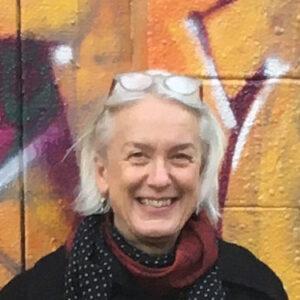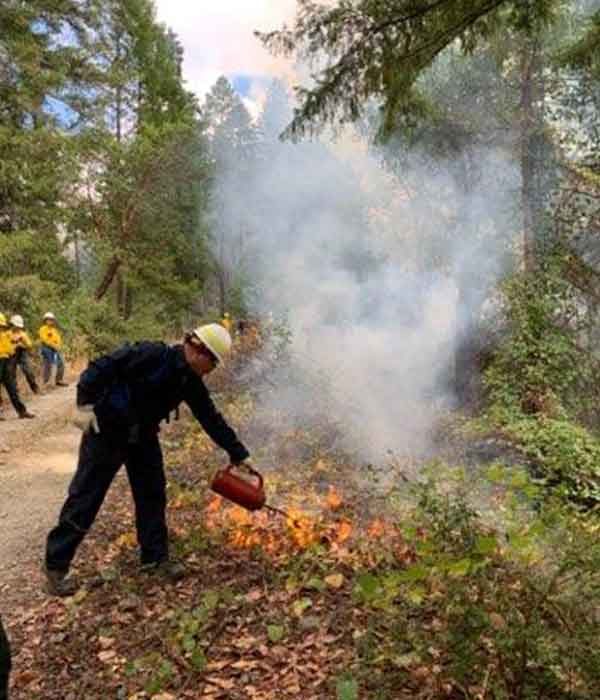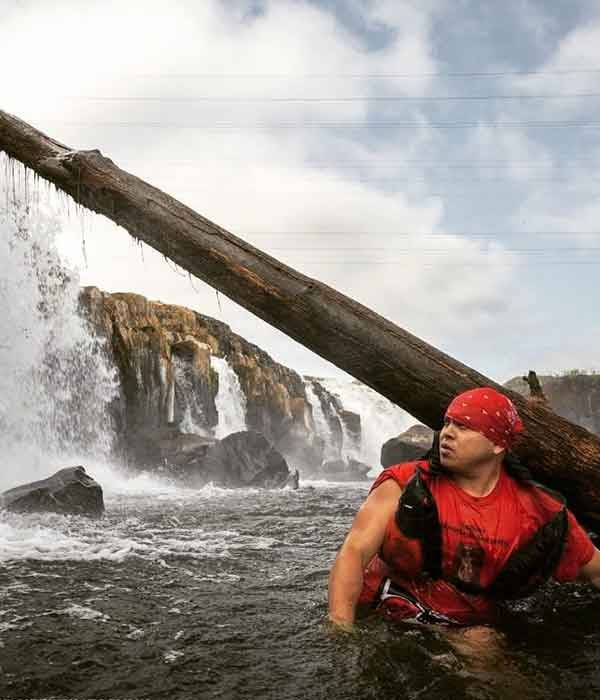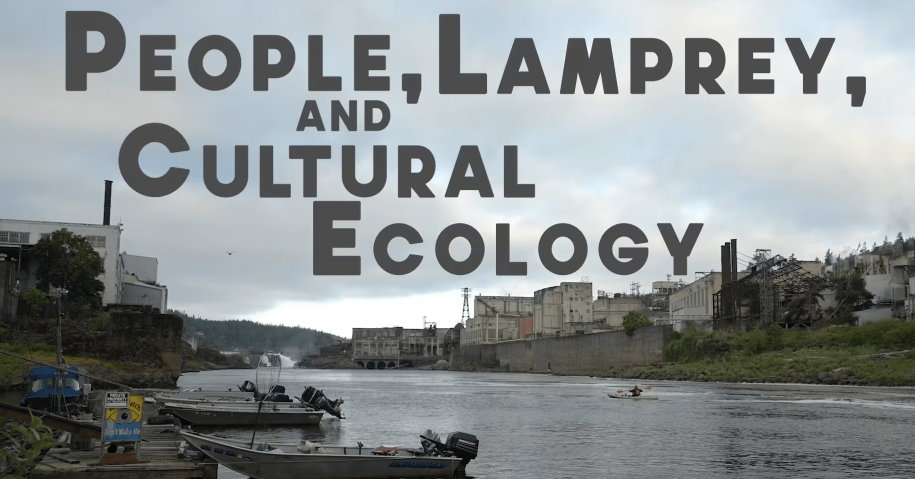
Guest Writer
Gabe Sheoships holding a lamprey eel. Photo credit: Jeremy Monroe, Freshwaters Illustrated
Gabe Sheoships is a 2023 Indigenous Leadership Awardee being celebrated as an emerging leader for his efforts to decolonize environmental education, re-Indigenize landscapes, and advocate for Indigenous-led stewardship and First Foods protection.
The slippery wriggling lamprey, seven breathing holes on both sides of its body, is often mistakenly called an eel. It’s not hard to see why. The grey-green cartilaginous fish has no bones and a suction-cup rasping mouth ringed with sharp teeth. Scientists call it an ancient “superclass” of jawless fish that evolved more than 450 million years ago, one of the oldest lineages in the world.
Lamprey, sacred for tribal people as both food and a cultural teacher, are “key to human survival and resilience,” said Gabe Sheoships, Executive Director of Friends of Tryon Creek. Even though lamprey have been absent from the creek for many decades, Sheoships sees a future when lamprey return to spawn and mature. Tryon Creek is a tributary that joins the Willamette River just a mile downstream.
“This is a pretty unique environment, smack dab in the middle of an urban area. Before Portland, Oregon became Stumptown, it looked something like this,” he said, sitting outside his office in the shade of Douglas fir, cedar, and maples in all directions. The cool breeze smells faintly of cedar. Birds chirp and twitter.
“
Our role is to care for each other whether it is burning the land to protect it or providing a way for lamprey to come home.
—GABE SHEOSHIPS
Gabe Sheoships (Cayuse/Walla Walla) is honored for his efforts to build authentic narratives in environmental education, focusing on the give-and-take of relationships of people to the land, plants, and animals. He is recognized for stewarding the land and protecting First Foods and his unwavering commitment to the needs of Indigenous communities to thrive and maintain their sovereignty.
Under his leadership, Friends of Tryon Creek has shifted away from a linear world view toward an Indigenous relational perspective, he said. The environmental education programs at Tryon Creek have been recalibrated to show the connection of humans to the natural world, where plants, animals, people, and natural systems are equally valued.
The ideas of land that is owned and occupied are set aside and replaced by Indigenous values and respect. People and the natural world thrive because of, not despite, the other, he said — a view of the world that is collective, balanced, and holistic. It looks forward and backward for seven generations. Youth are honored for the future they represent, and elders are valued for their wisdom and advice. Our role, Sheoships said, is to care for each other whether it is burning the land to protect it or providing a way for lamprey to come home.

Photo courtesy of Gabe Sheoships

Gabe Sheoships. Photo credit: Freshwaters Illustrated
Sheoships, a fisheries biologist, is both an educator and a scientist. He earned a bachelor’s degree from Portland State University and a master’s degree in fisheries biology from Oregon State University, with a focus on understanding critical habitat within the Columbia River Basin in relation to lamprey. He worked as a technician at the Columbia River Inter-Tribal Fish Commission for eight years before being hired at Tryon Creek. Since 2016, he has taught in multiple departments at Portland State University, including Indigenous Nations Studies, Environmental Science and Management, and the Hatfield School of Government. In addition, he serves on multiple nonprofit boards.
Western education, he said, leaves out many of the important teachings that are central to Indigenous communities. His goal is shifting the emphasis of environmental programs to strengthen families by connecting the dots from parents and children to education, better health, and stronger economic outcomes. Investing in youth is a crucial ingredient in all the work he does, whether it is in his role at Tryon Creek or as a volunteer.
“
We are working to promote holistic access for people to this park, to restore native communities of fish and provide them with return to this place, which is also their home. We’re laying that groundwork where lamprey will come back to this creek.
—GABE SHEOSHIPS

An image from “PLACE – People, Lamprey, and Cultural Ecology,” a video featuring Gabe Sheoships about ancient cultural practice and connections between migratory fish, urban forests, and community stewardship. Click here to watch the video. Video by Freshwaters Illustrator.
Additionally, to make Indigenous values visible, Sheoships plans to create an outdoor pavilion centered around Indigenous art by Native artists. This one-of-a-kind education center will be grounded in ancestral design that honors the original stewards of the forest and amplifies Indigenous cultural art and values with a theme of trade and confluence.
Recalling his own public school education, he says that Indigenous history tends to be left out or is heavily abridged. Friends of Tryon Creek programs, said Sheoships, will tell an accurate story of Native people. It will also be a place where lamprey will come back to spawn, a small trickle of a creek that grows and shrinks depending on the season with input from five tributaries. The main impediment to a more robust creek is a culvert so big it’s possible to stand in it.
“Modern Western society has created a lot of barriers, both physical and socio-emotional, whether in a river or a societal structure, that limits folks from retaining their cultural knowledge or accessing a forest like this,” he said. Somehow, said Sheoships, lamprey have been able to survive for a long time, even though they are more climbers than swimmers, moving slow, swimming slowly.
“
If more people care about the natural world, they will have that knowledge to take with them in life.
—GABE SHEOSHIPS
Many tribes tell stories about lamprey, he said, like the one about boastful, cocky lamprey and how he lost his bones. Lamprey bet suckerfish he would win a race against him and, sure enough, lamprey not only lost the race but lost his bones, a lesson in being humble.
“I love lamprey. If more people care about the natural world, they will have that knowledge to take with them in life,” he said. “Lamprey are a great teacher of that.”
Gabe Sheoships shares remarks and reflections during the 2023 Indigenous Leadership Awards ceremony.

PRESS RELEASE
PORTLAND, Ore. — July 17, 2023 — Ecotrust today announced the recipients of the 2023 Indigenous Leadership Awards.

BLOG
INTERVIEW | An interview with Gabe Sheoships, the Executive Director of the Friends of Tryon Creek

VIDEO
Follow Cayuse Tribal Member, Gabe Sheoships, into an ancient cultural practice, and discover the connections between migratory fish, urban forests, and community stewardship… and the work one group is doing to re-build the strength of these connections for future generations. Video by Freshwaters Illustrated